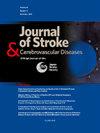外周血炎症生物标志物与成年脑卒中烟雾病患者不良临床结局的关联
IF 1.8
4区 医学
Q3 NEUROSCIENCES
Journal of Stroke & Cerebrovascular Diseases
Pub Date : 2025-05-16
DOI:10.1016/j.jstrokecerebrovasdis.2025.108351
引用次数: 0
摘要
目的:脑卒中是烟雾病(MMD)的常见表现。该研究旨在探讨炎症生物标志物与成年脑卒中合并烟雾病患者临床预后差的相关性。患者和方法:回顾性研究纳入2012年6月至2023年11月广西医科大学第一附属医院收治的成年烟雾病患者。功能结果采用改良Rankin量表(mRS)评分进行评估。我们评估了血小板与淋巴细胞比率(PLR)、中性粒细胞与淋巴细胞比率(NLR)、单核细胞与淋巴细胞比率(MLR)、全身免疫炎症指数(SII)和中性粒细胞与白蛋白比率(NAR)的曲线下面积(AUC),以预测不良的临床结果。结果:共收集201例符合条件的烟雾病患者,其中29例无卒中,97例缺血性卒中,75例出血卒中。在伴有缺血性脑卒中的烟雾病患者中,预后较差的患者SII和NAR水平明显较高。SII和NAR的AUC分别为0.667和0.684,而联合应用的AUC为0.683。在烟雾病合并出血性卒中患者中,预后较差的患者PLR、NLR、MLR、SII和NAR水平明显较高。AUC分别为0.678、0.727、0.643、0.751、0.744,而联合应用这些炎症生物标志物的AUC为0.793,高于单一指标。结论:高SII和NAR水平与烟雾病患者合并缺血性脑卒中的不良临床预后相关。较高的PLR、NLR、MLR、SII和NAR水平与烟雾病患者合并出血性卒中的不良临床结果相关。本文章由计算机程序翻译,如有差异,请以英文原文为准。
Association of peripheral blood inflammatory biomarkers and poor clinical outcomes in adult stroke patients with moyamoya disease
Purpose
Stroke is the common manifestation of moyamoya disease (MMD). The study aimed to explore the correlation between inflammatory biomarkers and the poor clinical outcomes in adult stroke patients with MMD.
Patients and methods
The retrospective study included adult patients with MMD who were admitted to the First Affiliated Hospital of Guangxi Medical University from June 2012 to November 2023. Functional outcomes were assessed using the modified Rankin Scale (mRS) score. We assessed the area under the curves (AUC) for platelet-to-lymphocyte ratio (PLR), neutrophil-to-lymphocyte ratio (NLR), monocyte-to-lymphocyte ratio (MLR), systemic immune-inflammation index (SII) and neutrophil-to-albumin ratio (NAR) in predicting the poor clinical outcomes.
Results
Overall 201 eligible MMD patients including 29 subjects without stroke, 97 subjects with ischemic stroke and 75 subjects with hemorrhagic stroke were collected. In MMD patients with ischemic stroke, those with poor outcomes had significantly higher levels of SII and NAR. The AUCs of SII and NAR were respectively 0.667 and 0.684, while the AUC for joint application was 0.683. In MMD patients with hemorrhagic stroke, those with poor outcomes had significantly higher levels of PLR, NLR, MLR, SII, and NAR. And the AUCs were respectively 0.678, 0.727, 0.643, 0.751, 0.744, while the AUC for joint application of these inflammatory biomarkers was 0.793, higher than a single indicator.
Conclusion
Higher SII and NAR levels were associated with poor clinical outcomes in MMD patients with ischemic stroke. Higher PLR, NLR, MLR, SII, and NAR levels were associated with poor clinical outcomes in MMD patients with hemorrhagic stroke.
求助全文
通过发布文献求助,成功后即可免费获取论文全文。
去求助
来源期刊

Journal of Stroke & Cerebrovascular Diseases
Medicine-Surgery
CiteScore
5.00
自引率
4.00%
发文量
583
审稿时长
62 days
期刊介绍:
The Journal of Stroke & Cerebrovascular Diseases publishes original papers on basic and clinical science related to the fields of stroke and cerebrovascular diseases. The Journal also features review articles, controversies, methods and technical notes, selected case reports and other original articles of special nature. Its editorial mission is to focus on prevention and repair of cerebrovascular disease. Clinical papers emphasize medical and surgical aspects of stroke, clinical trials and design, epidemiology, stroke care delivery systems and outcomes, imaging sciences and rehabilitation of stroke. The Journal will be of special interest to specialists involved in caring for patients with cerebrovascular disease, including neurologists, neurosurgeons and cardiologists.
 求助内容:
求助内容: 应助结果提醒方式:
应助结果提醒方式:


